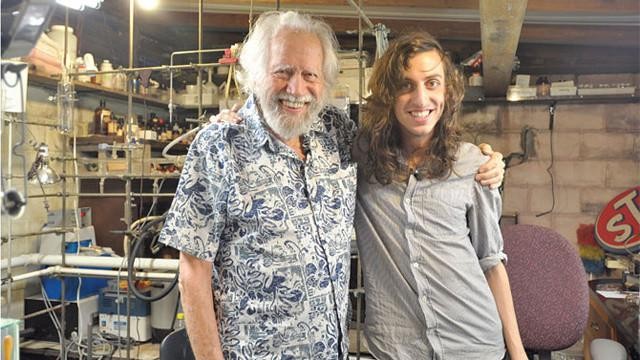Photo via Dominic Simpson/Flickr
Around two months ago, an underground queer dance party in LA emailed an invite to an upcoming event. The party in question—whose promoter wished to remain anonymous, because their events are not public—has been ongoing for five years, and this invite, by all accounts, looked largely like those that had come before, save for a stern warning at the bottom. “NEW POLICY: We are sick of calling ambulances, so we'll be searching for GHB at the door,” it read. “If we have to remove you from the event for using GHB, you, and everyone in your crew, will be blacklisted from all future events. Handle your shit.”The promoter was compelled to include the warning after witnessing a sharp rise in revelers overdosing on the drug at his events. When they do, “they can’t stand up, they look passed out and unresponsive, they throw up, they piss themselves,” he said. “When it’s really bad, there’s involuntary twitching and seizures.” And because taking too much GHB can inhibit respiratory functions, leading to coma or even death, partygoers who pass out while on the drug require urgent care from emergency personnel. This represents a particular liability in the underground queer scene, where a single 911 call can give away the location of a party and lead authorities to shut down a venue indefinitely.“When you endanger our ability to throw parties for everyone else, it’s really fucking selfish on your part,” the promoter added.First synthesized as a research chemical and anesthetic in France in the 1960s, GHB burst onto the club scene in 1980s. Best known as a date rape drug, it quickly gained a following among both gay and straight people for producing a dissociative alcohol-like high without the hangover or beer belly. Though its rate of use is little-studied, by some measures it’s on the rise, especially among queer people and in the dance music scene. The drug is notoriously difficult to dose, and because it’s typically diluted with liquids, the difference between a good time and a disastrous night is easy to miscalculate.To boot, GHB is often carried in small vials, meaning it’s easy to hide on your person. “I'm sure it's easy for anyone to get it past security, no matter what,” said the party promoter. In addition to being relatively inconspicuous, GHB is also not particularly difficult to acquire; GBL, a substance that can be manufactured into GHB at home by following a few googleable steps, can be bought online by the liter.Luke Howard, an international DJ who also works for the LGBTQ addiction resource center Antidote, said the substance became so popular in the UK that it nearly destroyed gay nightlife in the late aughts. “There was a campaign against it in London in the gay press 10 years ago because it was basically ruining the club scene,” he said. Today, though, he said British gay men associate it more with chemsex. “That’s one of the things that’s changed—it’s not such a crisis in UK clubs anymore. People use it now more at private parties.”According to a study first reported by BuzzFeed, the number of GHB-related deaths in London more than doubled between 2014 and 2015. And the dark recess of a nightclub is far from an ideal place to measure out a dosage of GHB that won’t make you pass out. According a DEA fact sheet, the average GHB dose is one to five grams and can take anywhere from 15 to 30 minutes to kick in, but dealers and users typically measure out GHB by the capful, and slipups are common.“The danger in these sedatives is you go from experiencing a little bit of a euphoria to becoming completely comatose,” said Raymond Ho, managing director of the California Poison Control Center. “You pass out and can end up choking on your vomit or the drug can decrease your respiratory rate and slow your heart to a dangerously low rhythm.”
Watch: Meet the Man Who Birthed Ecstasy in a Test-Tube
Some believe the number of GHB deaths is significantly higher than what’s been reported. Since 1990, sixteen thousand people have overdosed on GHB and 70 have died in the US, according to data provided by the Substance Aabuse and Mental Health Services Administration, but it can be difficult to diagnose the role GHB played in person’s death because the same compound is produced in human tissue, and the drug is cleared from the blood 2-6 hours after ingestion.The confusion over GHB’s role in deaths, as well as a lack of research on its epidemiology, has given the drug a stealthier profile than other so-called “club drugs.” “It’s usually used in combination with other drugs, primarily crystal meth,” said Mike Rizzo, manager of addiction recovery services at the LA LGBT Center. “It actually doesn’t even register on our database even though it’s definitely a factor in people’s substance abuse. It’s just not people’s primary diagnosis.”The lack of awareness affects the way people talk about the drug problems in their communities, he added. “When someone dies, people ask, ‘What was he using?’ The first answer is crystal meth, but then later it sometimes emerges that GHB was involved, too.”Howard said that while UK-based queer clubs have been somewhat successful in banning G, he believes the drug has since become more popular in US and German clubs. “I’ve DJed in New York and seen people pass out who were having a G attack,” he said. He added that overdoses are often terrifying to witness: “If you start to go under on G, you lose your capacity to stand,” he said. “You might bend over or double over, and you’re kind of in a state where you’re passing out. What happens next is similar to a coma, it’s very dangerous. The best thing to do is to get that person to an ER.”The California Poison Control has seen fewer calls for GHB overdoses in recent years, but Ho said he doesn’t know if the decrease can be attributable to fewer people using it. “Once in a while, though, you still have someone come in from the club totally comatose and then you get a report back that they’d taken the drug,” he added.Ho said that ER doctors in major cities tend to be better trained these days about how to respond to club drug overdoses. “There’s good supportive care that can help people until the drug wears off and their respiration and heart rate comes back. It’s somewhat rare, I believe, for someone to die unless they’re left alone and not given help.”While Howard understands club owners’ worries, he stresses that G users deserve sympathy, not scorn.“It’s concerning for me to hear these anecdotal stories about G overdoses in New York or Berlin, because I feel if people don’t know what advice to give or how to treat people then we will see more deaths and more clubs close down,” he said. “But what needs to happen is a positive response. We shouldn’t marginalize or stigmatize people. Turning them into ‘unwanted people’ doesn’t solve the problem.”Follow Steven Blum on Twitter.
Advertisement
Advertisement
Advertisement
Watch: Meet the Man Who Birthed Ecstasy in a Test-Tube

Some believe the number of GHB deaths is significantly higher than what’s been reported. Since 1990, sixteen thousand people have overdosed on GHB and 70 have died in the US, according to data provided by the Substance Aabuse and Mental Health Services Administration, but it can be difficult to diagnose the role GHB played in person’s death because the same compound is produced in human tissue, and the drug is cleared from the blood 2-6 hours after ingestion.The confusion over GHB’s role in deaths, as well as a lack of research on its epidemiology, has given the drug a stealthier profile than other so-called “club drugs.” “It’s usually used in combination with other drugs, primarily crystal meth,” said Mike Rizzo, manager of addiction recovery services at the LA LGBT Center. “It actually doesn’t even register on our database even though it’s definitely a factor in people’s substance abuse. It’s just not people’s primary diagnosis.”The lack of awareness affects the way people talk about the drug problems in their communities, he added. “When someone dies, people ask, ‘What was he using?’ The first answer is crystal meth, but then later it sometimes emerges that GHB was involved, too.”
Advertisement
